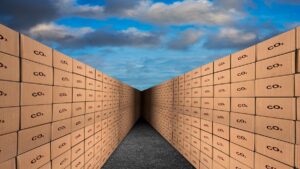Australia gets tougher on emissions, argues CCS is a must have

Pic: Via Getty Images
The case for carbon capture and storage (CCS) just got a whole lot stronger thanks to the Safeguard Mechanism reforms and the findings of an independent review of Australian Carbon Credit Units (ACCUs) that supports the need for additional measures beyond just offsetting emissions to meet carbon reduction targets.
The Australian government plans to implement tougher measures to force the country’s biggest emitters to slash their carbon footprint by almost 5% each year, which Climate Change and Energy Minister Chris Bowen argues will require other forms of abatement.
While Australian carbon credits will still be allowed for hard-to-abate industries, Bowen told the Australian Financial Review recently that offsets should not be the default means of abatement because many industries would be able to find real cuts to their emissions that cost less than the price of ACCUs. Importantly, Safeguard facilities will not be able to use international credits to meet the baseline reductions.
This includes the long-proven CCS technology, which has been in use since the early 1970s on a commercial scale and is not only effective in reducing existing emissions but is also crucial for enabling the production of cheaper and cleaner blue hydrogen.
“We can’t be putting abatement off for the never-never,” Bowen told the AFR.
“I accept that different sectors are at different stages of available technology. That’s why the safeguard facility provides that flexibility because some sectors have relatively low-cost abatement technology right now and others have it under development, and others like cement are very hard to abate.”
In the near term, commencing FY 2024, Safeguard facilities are expected to satisfy the obligation to reduce baseline emissions by purchasing offset based ACCUs. It is expected that this activity will absorb the current oversupply of ACCUs in the market and see the market price align with international carbon credit benchmarks.
The reforms include an industry assistance package with the government to provide ACCUs at a capped price of $75/tonne to certain facilities. The cap price will increase to around $110/tonne by 2032. The current market price for ACCU is around $40/tonne.
Safeguard facilities will have priority access to $600m of the $1.9 billion Powering the Regions Fund (PRF) to support decarbonisation and further support for trade exposed entities with significant review impacts.
A key element of the reform of the Safeguard Mechanism is that Australian facilities covered by the mechanism cannot rely on meeting their 4.9% annual CO2 emissions reduction requirement by using CO2 offsets from international sources which have the potential to be of low quality and difficult to confirm or verify the actual CO2 emissions offset.
The Safeguard Mechanism reforms will also have a substantial impact on new CO2 emissions sources by requiring these new facilities to meet international best practice emissions standard in setting the Safeguard Mechanism baseline that the annual reduction target will apply to.
This need to meet international emissions best practice could have a significant impact on natural gas production and processing facilities as well as fertiliser manufacturing, given that internationally major facilities are already moving quickly to implement emissions reductions through CCS especially with the impact of the Inflation Reduction Act in the United States.
Australian states are also getting tougher on emissions, with Western Australia to become the third state, after Victoria and Tasmania, to formally legislate its target to reach net zero by 2050.
Premier Mark McGowan is introducing the legislation to Parliament this year which will also include a mandate for five-yearly emissions targets, The West Australian reported this week.
CCS frontrunners
Pilot Energy (ASX:PGY) and partner Triangle Energy (ASX:TEG) are much further down the track towards bringing Australia’s first offshore CCS project into operation than the rest.
Late last year, they became the first in Australia to lodge a submission seeking regulatory approvals for an offshore CCS project under legislation that has been in place since 2006.
The partners successfully lodged their application to the National Offshore Petroleum Titles Administrator (NOPTA) to have the Cliff Head Oil Field in Western Australia’s Mid West declared as an identified greenhouse gas storage formation.
The project would provide CCS services to third parties and support the subsequent production of blue hydrogen and ammonia.
Studies have shown the Cliff Head CCS project would be capable of initially storing 9.7 million tonnes of CO2 at an injection rate of 665,000 tonnes per annum for about 15 years.
But it has substantial estimated storage potential of up to 50 million tonnes.
CCS would be particularly beneficial in helping reduce carbon emissions from gas projects like Waitsia in the Perth Basin.
Brad Lingo, chairman of Pilot Energy, told Stockhead previously the Waitsia project would involve the processing of 300,000 tonnes of CO2 associated with gas production that would be vented instead of sequestered.
“Many of the gas fields in the Cooper Basin have 30-40% CO2 in the raw gas, all processed out and vented,” he added.
The Cliff Head Oil Field is the only late-life offshore reservoir located in the WA Mid-West region with a Commonwealth regulatory pathway to CCS.
In both Australia and overseas, there are very few CCS projects in the pipeline and the ones on the agenda are targeted to be in operation closer to 2030.
The Cliff Head CCS project, however, is scheduled to be capturing and storing CO2 by 2025/2026.
This has prompted strong interest from major players in Australia, Japan, and South Korea.
This article was developed in collaboration with Pilot Energy, a Stockhead advertiser at the time of publishing.
This article does not constitute financial product advice. You should consider obtaining independent advice before making any financial decisions.
Related Topics

UNLOCK INSIGHTS
Discover the untold stories of emerging ASX stocks.
Daily news and expert analysis, it's free to subscribe.
By proceeding, you confirm you understand that we handle personal information in accordance with our Privacy Policy.








